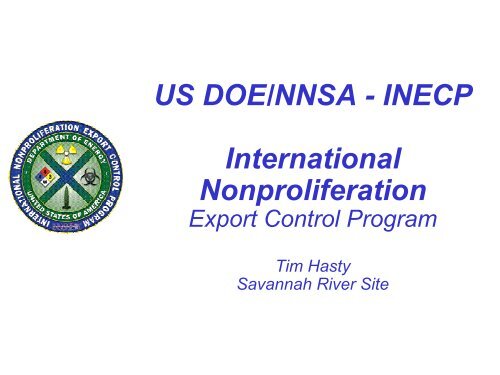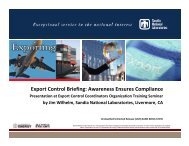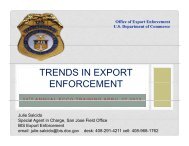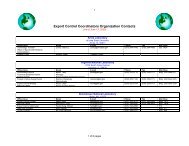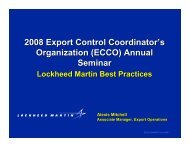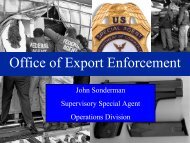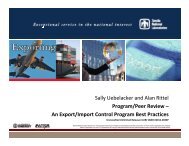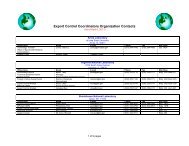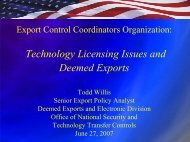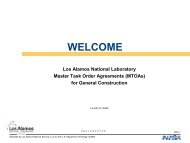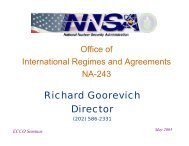INECP International Nonproliferation - Acquisition Services ...
INECP International Nonproliferation - Acquisition Services ...
INECP International Nonproliferation - Acquisition Services ...
You also want an ePaper? Increase the reach of your titles
YUMPU automatically turns print PDFs into web optimized ePapers that Google loves.
US DOE/NNSA - <strong>INECP</strong><br />
<strong>International</strong><br />
<strong>Nonproliferation</strong><br />
Export Control Program<br />
Tim Hasty<br />
Savannah River Site
2<br />
<strong>INECP</strong> Presentation Outline<br />
• Overview, Mission, History<br />
• Proliferation Risk and Assessment-Based Engagement Process<br />
• Spotlights on Three Main Pillars of <strong>INECP</strong> Activity<br />
- Licensing<br />
- Enterprise Outreach<br />
- Enforcement<br />
• <strong>INECP</strong> Today
<strong>International</strong> <strong>Nonproliferation</strong><br />
Export Control Program<br />
3<br />
MISSION<br />
• Strengthen global<br />
efforts to prevent<br />
proliferation of<br />
WMD-related<br />
materials,<br />
equipment, and<br />
technology<br />
• Proliferation Risk Analysis in the Licensing<br />
Process<br />
AREAS OF ENGAGEMENT<br />
- Ensure the license review process competently<br />
assesses proliferation risks associated with enduses<br />
and end-users, and ensure technical<br />
specialists are being utilized<br />
• Government Outreach and Enterprise<br />
Compliance<br />
- Assist governments to establish outreach<br />
programs and promote enterprise compliance at<br />
key enterprises and technology holders<br />
• WMD-related Commodity Identification Training<br />
and reach-back for Customs<br />
- Ensure enforcement personnel are sensitized to<br />
WMD-related materials and equipment, and<br />
have access to technical/analytical resources<br />
and support
<strong>International</strong> <strong>Nonproliferation</strong> Export<br />
Control Program (<strong>INECP</strong>)<br />
4<br />
• Threat<br />
- Networks of procurement agents, brokers, and companies<br />
systematically maneuver around and through national export control<br />
efforts to obtain commodities and technology needed for WMD<br />
development and production facilities<br />
• <strong>INECP</strong> Mission<br />
- Strengthen global efforts to prevent proliferation of WMD-related<br />
materials, equipment, and technology
Responding to the dynamic threat<br />
…<strong>INECP</strong> evolution over time<br />
5<br />
• 1990’s:<br />
- <strong>INECP</strong> helped create export control systems from whole cloth in the<br />
Newly Independent States starting in the mid-1990s, focusing on the<br />
key nuclear suppliers<br />
- Russia, Ukraine, and Kazakhstan<br />
- Initial focus was on outreach to nuclear enterprises and the creation<br />
of licensing systems<br />
<strong>INECP</strong>’s approach is based on identifying, training, and developing a cadre of<br />
technical/nonproliferation specialists in each partner country that can sustain that<br />
country’s export control system over the long term
Responding to the dynamic threat<br />
…<strong>INECP</strong> evolution over time<br />
6<br />
• 2000’s:<br />
- Systematic threat assessment drove geographic expansion<br />
- 1st phase of geographic expansion took the program to the transit<br />
states adjacent to the “big-3” nuclear suppliers:<br />
- Caucasus, Central Asia, Baltics<br />
- 2nd phase (post 9/11), recognizing the threats of procurement<br />
networks, non-state actors, weak links in the regime, and secondary<br />
suppliers took the program global:<br />
- Asia Pacific, Middle East, Europe, Americas<br />
- Systematic vulnerability assessment drove topical expansion<br />
- Recognition that effective export control systems depend not only on<br />
licensing and enterprise compliance, but also on the ability of<br />
frontline enforcement agencies to interdict illicit trade, led to<br />
development of Commodity Identification Training (CIT)<br />
<strong>INECP</strong>’s Country Plans implement these systematic assessments
7<br />
<strong>INECP</strong>’s Global Proliferation Risk Assessment<br />
guides country selection and prioritization<br />
• Risk is based on Threat and Vulnerability<br />
- Threat = Supply Threat and Conduit Threat<br />
- Supply Threat = capacity to supply CBNM-related goods<br />
- Conduit Threat = Geostrategic position and trade flows<br />
- Vulnerability = Export Control System defects<br />
- Three elements necessary for export control system effectiveness<br />
- Licensing<br />
- Enterprise Compliance<br />
- Enforcement<br />
- Defects in any of these system elements create opportunities for<br />
proliferators
8<br />
Measuring Proliferation THREAT<br />
• Threat = Supply Threat and Conduit Threat<br />
- Supply Threat = capacity to supply CBNM-related goods<br />
- Conduit Threat = Geostrategic position and trade flows indicate access to<br />
goods and opportunities for diversion<br />
Potential Supply Threat<br />
Potential Conduit Threat<br />
5<br />
Clear capacity to provide the<br />
most vital and sensitive items<br />
and know-how.<br />
Suspected/known NW program<br />
or possesses enrichment or<br />
reprocessing facilities<br />
Military producer of Cat 1<br />
systems and/or posesses<br />
ICBM capability<br />
Suspected/known CW program Suspected/known BW program<br />
5 Regime Insider*<br />
Significant trading partner with<br />
countries pursuing WMD<br />
programs<br />
4<br />
Ability to provide more<br />
sensitive items and know-how<br />
Produces/Supplies nuclear fuel<br />
cycle faciliites (NSG TL)<br />
Space launch program or<br />
produces MTCR Cat I systems<br />
Schedule 1 chemical<br />
production capability or legacy<br />
CW program<br />
Declared or suspected<br />
biodefense program or BW<br />
legacy program<br />
4<br />
Significant trading partner with<br />
a regime insider*<br />
Operates a Free Trade Zone**<br />
3<br />
Clear capacity to supply many<br />
of the relevant dual-use<br />
commodities and technology<br />
Produces/Supplies NSG DU<br />
items<br />
Produces MTCR Cat II systems<br />
or subsystems<br />
Produces/supplies Schedule 2<br />
chemicals or AG DU chemical<br />
production equipment<br />
Bio-related DU equipment<br />
supplier<br />
3<br />
Geographically adjacent to a<br />
regime insider*<br />
Major transit/transshipment<br />
hub<br />
2<br />
Ability to provide at least some<br />
strategic commodities on the<br />
multilateral export control lists<br />
Nuclear technology holder<br />
Active aerospace industry<br />
Produces/supplies<br />
unscheduled or Schedule 3<br />
chemicals or utilizes them in<br />
domestic industry<br />
Active biotech or<br />
pharmaceutical industry<br />
2<br />
Adjacent to a country pursuing<br />
WMD<br />
Significant international trade<br />
relative to GDP<br />
1<br />
Virtually no capacity to supply<br />
the necessary goods<br />
None<br />
None<br />
Minimal capability for producing Minimal capability for producing<br />
controlled chemicals<br />
bio-agents<br />
1 Isolated Minimal trade<br />
GENERAL<br />
Nuclear<br />
Supplier<br />
Missile<br />
Supplier<br />
Chemical<br />
Supplier<br />
Biological<br />
Supplier<br />
Geo-strategic<br />
Trade Flows<br />
position<br />
* "regime insider" includes members of the NSG, MTCR, or AG, as well as<br />
countries inside a customs union or open market with a regime member<br />
**<br />
"free trade zone" encompasses the broader category of special economic<br />
zones, including free ports, export-processing zones, special economic zones,<br />
etc.
9<br />
Measuring VULNERABILITY<br />
- Defects in any of these system elements create opportunities for illicit<br />
procurement<br />
- Licensing<br />
- Enterprise Compliance<br />
- Enforcement<br />
1 2 3 4 5<br />
Licensing<br />
Proliferation Risk<br />
Analysis in Licensing<br />
Process<br />
No licensing process and no<br />
dual-use control lists<br />
Licensing agencies/process<br />
identified and rudimentary<br />
control lists in place<br />
Ad hoc links between technical<br />
expertise and licensors<br />
employed to review licenses<br />
and Control lists consistent<br />
NSG Part 1 or AP Annex II.<br />
Dedicated/trained groups of<br />
nonproliferation technical<br />
specialists capable of reviewing<br />
DU licenses are used and<br />
control lists consistent NSG Part<br />
2.<br />
Competent proliferation risk<br />
evaluation, including end<br />
use and end user analysis<br />
and ontrol lists consistent<br />
NSG/MTCR/AG/WA.<br />
Enterprises<br />
Government Outreach<br />
to Industry<br />
No inventory of enterprises<br />
Enterprises identified;<br />
Guidelines Promulgated<br />
Outreach happening but not to<br />
all key enterprises<br />
US-supported, indigenouslystaffed<br />
outreach to key<br />
suppliers<br />
Self-sustainable,<br />
indigenous outreach at all<br />
key enterprises<br />
Enforcement<br />
WMD/DU Training and<br />
Reachback for<br />
Customs<br />
No training or no technical<br />
expertise available<br />
Basic export control training<br />
for enforcement officials and<br />
Technical Experts Identified<br />
CIT indigenization underway<br />
and<br />
Ad hoc referrals to technical<br />
experts<br />
Ongoing US-supported CIT and<br />
regularized reachback between<br />
front line and technical experts<br />
established<br />
Indigenous and locally<br />
customized CIT established<br />
and Technical experts<br />
trained and equipped to<br />
provide support as<br />
requested
The combination of threat and vulnerability guides<br />
<strong>INECP</strong>’s country selection and prioritization<br />
<strong>INECP</strong> Global Risk Assessment<br />
100%<br />
UAE<br />
Kyrgyzstan<br />
Malaysia<br />
Indonesia Vietnam Thailand<br />
Jordan<br />
Mexico<br />
S&M<br />
Croatia<br />
Philippines Azerbaijan<br />
Georgia<br />
Macedonia<br />
Israel<br />
Pakistan<br />
System Vulnerability<br />
50%<br />
Iceland<br />
New Zealand<br />
Singapore<br />
KAZ<br />
Turkey<br />
HK<br />
Armenia<br />
Argentina Taiwan<br />
Canada<br />
SF<br />
India Brazil<br />
Ukraine<br />
ROK<br />
Japan<br />
China<br />
EU<br />
Russia<br />
US<br />
AUS<br />
0%<br />
0% 50% 100%<br />
Proliferation Threat<br />
10
The combination of threat and vulnerability guides<br />
<strong>INECP</strong>’s country selection and prioritization<br />
11
12<br />
Tailored ENGAGEMENT<br />
1 2 3 4 5<br />
• For each country engaged,<br />
<strong>INECP</strong> tailors its approach<br />
according to the assessed<br />
deficiencies in the three<br />
export control system<br />
elements<br />
• The Evaluation and<br />
Planning Matrix diagnoses<br />
the export control<br />
deficiencies that <strong>INECP</strong> can<br />
most effectively target and<br />
identifies specific offerings<br />
to address those<br />
deficiencies<br />
• This matrix forms the basis<br />
for all of <strong>INECP</strong>’s annually<br />
updated Country Plans.<br />
Licensing<br />
Enterprises<br />
Enforcement<br />
Proliferation Risk Analysis in Licensing Process<br />
WMD/DU Training and Reachback for Customs Government Outreach to Industry<br />
<strong>INECP</strong> Offerings<br />
Metric<br />
<strong>INECP</strong> Offerings<br />
Metric<br />
<strong>INECP</strong> Offerings<br />
Metric<br />
No licensing process and no<br />
dual-use control lists<br />
Tech Exchange<br />
Proliferation Awareness<br />
Workshop<br />
Gap Analysis<br />
No inventory of enterprises<br />
Tech Exchange<br />
Proliferation Awareness<br />
Workshop<br />
Identify/train cadre to<br />
conduct outreach<br />
Indigenous enterprise study<br />
No training or no technical<br />
expertise available<br />
CIT Short-Course<br />
Identify potential sources of<br />
tech expertise<br />
Trade Flow Analysis<br />
Technical Exchange<br />
Licensing agencies/process<br />
identified and rudimentary<br />
control lists in place<br />
ELAN<br />
End Use/End User Training<br />
I<br />
Share DOE<br />
Handbooks/Guidebooks<br />
Multilat Workshop I<br />
Enterprises identified;<br />
Guidelines Promulgated<br />
Government-industry<br />
seminar<br />
Outreach<br />
dataproducts/websites<br />
Basic export control training<br />
for enforcement officials and<br />
Technical Experts Identified<br />
Develop Training Plan<br />
Share CIT Instructional<br />
Materials<br />
CIT Instructor Training<br />
Share DOE<br />
Handbooks/Guidebooks<br />
<strong>Nonproliferation</strong>/Tech<br />
Training (e.g., ELAN)<br />
Ad hoc links between technical<br />
expertise and licensors<br />
employed to review licenses<br />
and Control lists consistent<br />
NSG Part 1 or AP Annex II.<br />
Contract with tech experts<br />
TEWG<br />
NSG Outreach Workshop<br />
Outreach happening but not to<br />
all key enterprises<br />
Site-specific, industryspecific,<br />
or regional<br />
outreach workshops to:<br />
1. nuclear suppliers<br />
2. nuc tech holders<br />
3. AP Annex I Activities<br />
4. WMD DU enterprises<br />
CIT indigenization underway<br />
and ad-hoc referrals to<br />
technical experts<br />
TEWG<br />
Contract with tech experts<br />
Conduct needs analysis for<br />
tech tools and guides<br />
Contract development of<br />
indigenous guides<br />
Dedicated/trained groups of<br />
nonproliferation technical<br />
specialists capable of reviewing<br />
DU licenses are used and<br />
control lists consistent NSG Part<br />
2.<br />
End Use/End User Training II<br />
Multilat Workshop II<br />
Develop/Deploy Automated<br />
License Review<br />
US-supported, indigenouslystaffed<br />
outreach to key<br />
suppliers<br />
Site-Specific Workshops<br />
Handbook Development<br />
Negotiate transfer of<br />
responsibility<br />
Ongoing US-supported CIT and<br />
regularized reachback between<br />
front line and technical experts<br />
established<br />
Collaborative CIT Pilot<br />
Course(s)<br />
Deploy/train advanced tools<br />
(Vision Vest, XRF, etc)<br />
Competent proliferation risk<br />
evaluation, including end<br />
use and end user analysis<br />
and ontrol lists consistent<br />
NSG/MTCR/AG/WA.<br />
Maintenance<br />
Self-sustainable,<br />
indigenous outreach at all<br />
key enterprises<br />
Maintenance<br />
Indigenous and locally<br />
customized CIT established<br />
and Technical experts<br />
trained and equipped to<br />
provide support as<br />
requested<br />
Maintenance
13<br />
Three Pillars of <strong>INECP</strong> activity<br />
Major Activity Who Why What<br />
LICENSING<br />
Licensing Officers and<br />
Analysts<br />
Need to conduct<br />
competent proliferation<br />
risk analysis in the<br />
licensing process<br />
End Use and End User<br />
Analysis Training<br />
(EUEU)<br />
COMPLIANCE<br />
Managers of public<br />
sector & legacy WMD<br />
enterprises, labs,<br />
manufacturers, etc.<br />
These major<br />
technology holders are<br />
targets of opportunity<br />
for proliferants<br />
Enterprise Outreach<br />
ENFORCEMENT<br />
Customs Officers and<br />
other enforcement<br />
personnel<br />
Widespread ignorance<br />
regarding strategic<br />
commodities<br />
Commodity<br />
Identification Training<br />
(CIT)
Spotlight on<br />
LICENSING<br />
• End Use/End User (EU/EU) Analysis focuses on strengthening the ability<br />
of analysts to uncover suspicious procurement activity and assess<br />
proliferation risk.<br />
• Analysis of Strategic Commodity Transfers (ASCOT) helps analysts better<br />
understand multilateral controls, including the commercial and WMD<br />
applications of listed commodities.<br />
commodity categorized<br />
correctly?<br />
commodity appropriate for the<br />
stated end use?<br />
(Quantity, specifications…)<br />
stated end use makes<br />
technical sense?<br />
stated end use consistent with<br />
the activities of the stated end<br />
user?<br />
existence and activities of<br />
the end user confirmed?<br />
Commodity<br />
Stated<br />
End<br />
Use<br />
Activities of the<br />
Consignees<br />
(including stated<br />
end user)<br />
reason for control?<br />
proliferation concern associated with<br />
this commodity?<br />
stated end use is a direct<br />
proliferation concern?<br />
history of diversion?<br />
connections to entities of concern?<br />
proliferation concerns or WMD activities<br />
associated with the end user country?<br />
14
Spotlight on<br />
Enterprise Outreach<br />
15<br />
• Our unique value added<br />
- Implementing compliance programs at US National Labs<br />
- Intangible technology control<br />
- Technical understanding of the control lists, commodities, WMD<br />
programs, acquisition networks<br />
• Our niche<br />
- Public sector, tertiary enterprises and legacy WMD sectors (nuclear,<br />
missile, chemical, biological)<br />
- <strong>INECP</strong>’s flexibility has also allowed us to quickly respond to partner<br />
government requests for assistance when other agencies cannot
Spotlight on<br />
Commodity Identification Training<br />
• CIT gives inspectors “a trained eye” by familiarizing<br />
them with the materials, components, and equipment<br />
sought by WMD procurement programs<br />
• CIT simplifies export control lists by grouping items into<br />
technology “bundles” and by aiding recognition through<br />
a focus on physical appearance, using pictures and<br />
demonstration kits:<br />
- Equipment<br />
- Fabricated Parts and Components<br />
- Electronics (Components and Equipment)<br />
- Industrial Equipment<br />
- Systems and Subsystems<br />
- Materials<br />
- Structural Materials (metals and non-metals)<br />
- Special Materials (Nuclear, Chemical, Biological)<br />
• Indigenization strategy<br />
- <strong>INECP</strong> follows a disciplined indigenization approach<br />
based on our technical partnerships to establish ongoing<br />
training programs and reachback capabilities<br />
Alloy Analysis with XRF provides<br />
capability to determine element<br />
composition of alloys and other<br />
controlled materials<br />
CIT deployment is underway in 25 countries<br />
16
ESTONIA<br />
v<br />
a<br />
y<br />
a<br />
17<br />
CIT Implementation Experience<br />
Commodity Identification<br />
Training<br />
SVALBARD<br />
Z E M LY A<br />
F R A N T S A<br />
I O S I F A<br />
S<br />
E V<br />
Z E M L Y A<br />
E R N A Y A<br />
GREENLAND<br />
Z e m l<br />
y a<br />
NOVOSIBIRSKIVE<br />
OSTROVO<br />
N o<br />
ICELAND<br />
NORWAY<br />
SWEDEN<br />
FINLAND<br />
R U S S I A<br />
A L E U T I A N<br />
I S L A N D S<br />
HAWAIIAN<br />
ISLANDS<br />
C A N A D A<br />
UNITED STATES OF AMERICA<br />
MEXICO<br />
GUATEMALA<br />
EL SALVADOR<br />
GALAPAGO<br />
S<br />
ISLANDS<br />
W E<br />
CUBA<br />
JAMAICA<br />
BELIZE<br />
HONDURAS<br />
COSTA RICA<br />
NICARAGUA<br />
PANAMA<br />
ECUADOR<br />
BAHAMAS<br />
S T I<br />
HAITI<br />
COLOMBIA<br />
PERU<br />
DOMINICAN<br />
REPUBLIC<br />
N D I<br />
VENEZUELA<br />
PUERTO RICO<br />
E<br />
S<br />
TRINIDAD &<br />
TOBAGO<br />
GUY ANA<br />
Newfoundland<br />
SURINAM<br />
FRENCH GUIANA<br />
B R A Z I L<br />
CANARY<br />
ISLANDS<br />
WESTERN<br />
SAHARA<br />
SENEGAL<br />
GAMBIA<br />
GUINEA-BISSAU<br />
SIERRA LEONE<br />
IRELAND<br />
PORTUGAL<br />
MOROCCO<br />
MAURITANIA<br />
GUINEA<br />
LIBERIA<br />
DENMARK<br />
SLOVENIA<br />
CROATIA<br />
BOSNIA-HERZEGOVINA<br />
ALBANIA<br />
LA TVIA<br />
LITHUANIA<br />
RUSSIA<br />
UNITED<br />
KINGDOM<br />
BELARUS<br />
GERMANY POLAND<br />
LUXEMBOURG CZECH<br />
REP. SLOVAKIA<br />
AUSTRIA<br />
UKRAINE<br />
HUNGARY MOLDOVA<br />
SWITZERLAND<br />
FRANCE<br />
ROMANIA<br />
SERBIA<br />
SPAIN ANDORRA<br />
BULGARIA<br />
GEORGIA<br />
ITALY MACEDONIA<br />
ARMENIA<br />
T U R K E Y<br />
GREECE<br />
IVORY<br />
COAST<br />
ALGERIA<br />
M A L I<br />
BURKINA<br />
FASO<br />
GHANA<br />
TOGO<br />
BENIN<br />
TUNISIA<br />
NIGER<br />
NIGERIA<br />
MALTA<br />
LIBYA<br />
CAMEROON<br />
EQUATORIAL<br />
GUINEA<br />
GABON CONGO<br />
CHAD<br />
CENTRAL<br />
AFRICAN<br />
REPUBLIC<br />
ANGOLA<br />
ZAIRE<br />
CYPRUS<br />
LEBANON<br />
ISRAEL<br />
EGYPT<br />
SUDAN<br />
RWANDA<br />
BURUNDI<br />
ZAMBIA<br />
ERITREA<br />
ETHIOPIA<br />
UGANDA KENYA SOMALIA<br />
TANZANIA<br />
MALAWI<br />
SYRIA<br />
JORDAN<br />
I R A Q<br />
SAUDI<br />
AZERBAIJAN UZBEKISTAN<br />
TURKMENISTAN<br />
IRAN<br />
ARABIA QATAR UNITED<br />
ARAB<br />
EMIRATES<br />
YEMEN<br />
OMAN<br />
KAZAKHSTAN<br />
AFGHANISTAN<br />
PAKISTAN<br />
KYRGYZSTAN<br />
TAJIKISTAN<br />
NEPAL<br />
I N D I A<br />
SRI<br />
LANKA<br />
BHUTAN<br />
BANGLADESH<br />
E<br />
MONGOLIA<br />
BURMA<br />
C H I N A<br />
LAOS<br />
THAILAND<br />
SINGAPORE<br />
A<br />
S<br />
T<br />
CAMBODIA<br />
VIETNAM<br />
BRUNEI<br />
MALAYSIA<br />
HONG KONG<br />
TAIWAN<br />
NORTH<br />
KOREA<br />
SOUTH KOREA<br />
PHILIPPINES<br />
I N D O N E S I A<br />
I N D I<br />
E<br />
S<br />
JAPAN<br />
M E<br />
L A<br />
PAPUA<br />
NEW<br />
GUINEA<br />
N E<br />
S I<br />
A<br />
SOLOMON<br />
ISLANDS<br />
BOLIVIA<br />
NAMIBIA<br />
MOZAMBIQUE<br />
ZIMBABWE<br />
MADAGASCAR<br />
MAURITIUS<br />
VANUATU<br />
FIJI<br />
PARAGUAY<br />
BOTSWANA<br />
RƒUNION<br />
NEW CALEDONIA<br />
CHILE<br />
SWAZILAND<br />
AUSTRALI A<br />
URUGUAY<br />
LESOTHO<br />
SOUTH AFRICA<br />
North I.<br />
ARGENTINA<br />
FALKLAND/MALVINAS<br />
ISLANDS<br />
CITConducted<br />
CIT Planned<br />
South I.<br />
NEW<br />
ZEALAND<br />
South Georgia
18<br />
<strong>INECP</strong> Today:<br />
• <strong>International</strong> Mandates bolster <strong>INECP</strong>’s timeliness and significance<br />
- UNSCR 1718 (sanctions on North Korea) benefited by <strong>INECP</strong> strategic commodity<br />
identification training in sensitive destinations surrounding North Korea (e.g., China,<br />
Hong Kong, Taiwan, Thailand, South Korea, Japan)<br />
- UNSCR 1696 (calling upon States to “to exercise vigilance and prevent the transfer of<br />
an items, materials, goods, and technology that could contribute to Iran’s<br />
…programmes”) benefited by <strong>INECP</strong> commodity identification and other export<br />
control training to potential suppliers and transit points: Cyprus, the European Union,<br />
Jordan, etc.<br />
- UNSCR 1540 includes provisions that reinforce <strong>INECP</strong>’s three pillars:<br />
- Improve Licensing Procedures & Practices: 3.(d) “Establish, develop, review and<br />
maintain appropriate effective national export and trans-shipment controls over<br />
such items…as well as establishing end-user controls…”<br />
- Promote Industry Compliance: 8.(d) “To develop appropriate ways to work with<br />
and inform industry and the public regarding their obligations under such laws;”<br />
- Strengthen Enforcement Capabilities: 3.(c) “Develop and maintain appropriate<br />
effective border controls and law enforcement efforts to detect, deter, prevent and<br />
combat…the illicit trafficking and brokering in such items…”
19<br />
<strong>INECP</strong> Today:<br />
• We are THE recognized experts in Strategic Commodity Control<br />
- CIT fills a critical need, and demand has far exceeded all<br />
expectations<br />
- The recognized need for CIT affords <strong>INECP</strong> ready access to a wide<br />
range of countries that would not otherwise accept “export control<br />
assistance”<br />
• Confidence in <strong>INECP</strong> results in Outreach Partnerships<br />
- Japan, Australia, EU<br />
- Technical Experts Working Groups<br />
• Regional institutions extend <strong>INECP</strong>’s reach and contacts<br />
- Cooperative Monitoring Center (CMC)<br />
- Council for Security Cooperation in the Asia Pacific (CSCAP)<br />
- European Commission Joint Research Centre (JRC)


